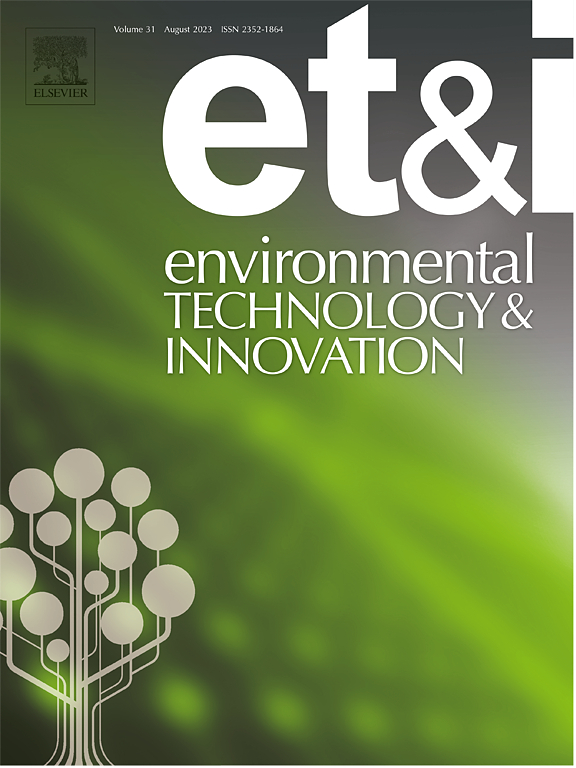Synergistic effects of biochar and abscisic acid improved root morphology, antioxidant defense system and decreased availability and bioaccumulation of cadmium in Triticum aestivum (L.) under cadmium stress
IF 6.7
2区 环境科学与生态学
Q1 BIOTECHNOLOGY & APPLIED MICROBIOLOGY
引用次数: 0
Abstract
Biochar (BC) and abscisic acid (ABA) may deliver positive physiological effects on heavy metal-stressed plants but their interactive role for regulating cadmium (Cd) availability in agricultural soils is unclear. This study revealed that the Cd-induced oxidative stress significantly reduced the growth of wheat, physiology and antioxidant responses. Interestingly, the co-application of BC (2.5 %) and ABA (20 μmol L−1) restored the growth of wheat plants by minimizing Cd accumulation and translocation than their single use. The co-application of these amendments significantly increased the tissues biomass by 36 %, total root volume (29 %), root surface area (44 %), foliar Chl-a and Chl-b by 59 % and 55 % at 10 mg kg−1 Cd than control. Elevated Cd levels increased the proline, MDA and H2O2 contents, while BC and ABA applications ameliorated the Cd-induced oxidative injury by boosting the enzymatic activities of catalase by 46 %, ascorbate-peroxidase by 46 % and peroxidase by 37 % at 10 mg kg−1 Cd. The Cd treatment also increased Cd levels in soil, root and shoot tissues of wheat plants. The co-application BC and ABA reduced DTPA-extractable soil Cd by about 3-fold at 5 mg kg−1 and by about 1.8-fold at 10 mg kg−1, as compared to respective controls. The combined BC + ABA treatment reduced Cd biological accumulation by 35 % and 33 %; and Cd translocation by 21 % and 9 % at 5 and 10 mg kg−1 Cd levels than control. It was concluded that the combined BC+ABA application restored the growth, physiology, antioxidant enzymatic activities and minimized Cd bioaccumulation in wheat tissues.
生物炭和脱落酸的协同作用改善了镉胁迫下小麦根系形态和抗氧化防御系统,降低了镉的有效性和生物积累量
生物炭(BC)和脱落酸(ABA)可能对重金属胁迫植物产生积极的生理效应,但它们在调节农业土壤镉(Cd)有效性方面的相互作用尚不清楚。本研究表明,cd诱导的氧化应激显著降低了小麦的生长、生理和抗氧化反应。有趣的是,与单独施用相比,复合施用BC(2.5 %)和ABA (20 μmol L−1)减少了Cd的积累和转运,从而恢复了小麦植株的生长。在10 mg kg−1 Cd处理下,与对照相比,共施用这些改良剂显著提高了组织生物量36 %,根系总体积29 %,根表面积44 %,叶片Chl-a和Chl-b分别提高了59 %和55 %。在10 mg kg−1 Cd处理下,添加BC和ABA可使过氧化氢酶活性提高46% %,抗坏血酸过氧化物酶活性提高46% %,过氧化物酶活性提高37% %,从而改善Cd诱导的氧化损伤。Cd处理还可提高小麦土壤、根和茎组织中的Cd水平。在5 mg kg−1和10 mg kg−1条件下,复合施用BC和ABA可使dtpa可提取土壤Cd分别降低约3倍和约1.8倍。BC + ABA联合处理使Cd的生物积累分别减少了35 %和33 %;在5和10 mg kg−1 Cd水平下,镉转运比对照分别减少21 %和9 %。综上所述,BC+ABA复合施用能恢复小麦的生长、生理、抗氧化酶活性,并能最大限度地减少Cd在小麦组织中的积累。
本文章由计算机程序翻译,如有差异,请以英文原文为准。
求助全文
约1分钟内获得全文
求助全文
来源期刊

Environmental Technology & Innovation
Environmental Science-General Environmental Science
CiteScore
14.00
自引率
4.20%
发文量
435
审稿时长
74 days
期刊介绍:
Environmental Technology & Innovation adopts a challenge-oriented approach to solutions by integrating natural sciences to promote a sustainable future. The journal aims to foster the creation and development of innovative products, technologies, and ideas that enhance the environment, with impacts across soil, air, water, and food in rural and urban areas.
As a platform for disseminating scientific evidence for environmental protection and sustainable development, the journal emphasizes fundamental science, methodologies, tools, techniques, and policy considerations. It emphasizes the importance of science and technology in environmental benefits, including smarter, cleaner technologies for environmental protection, more efficient resource processing methods, and the evidence supporting their effectiveness.
 求助内容:
求助内容: 应助结果提醒方式:
应助结果提醒方式:


